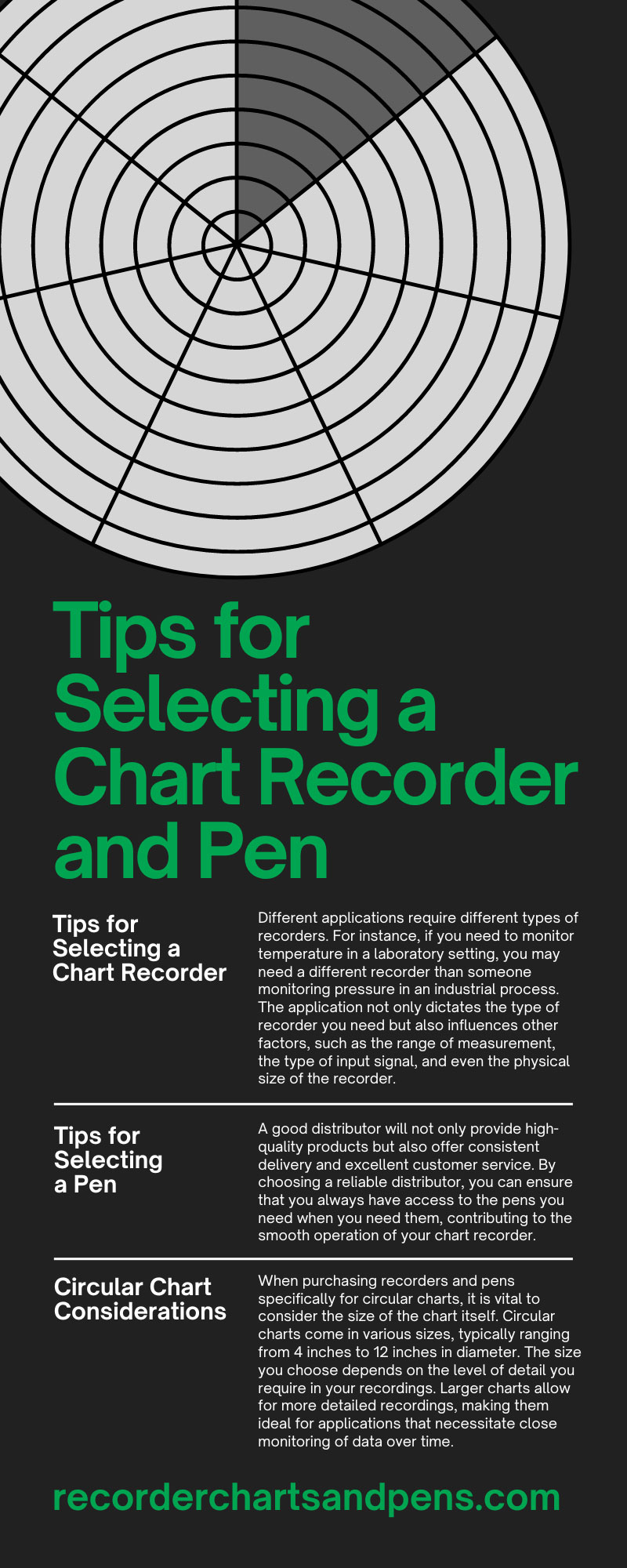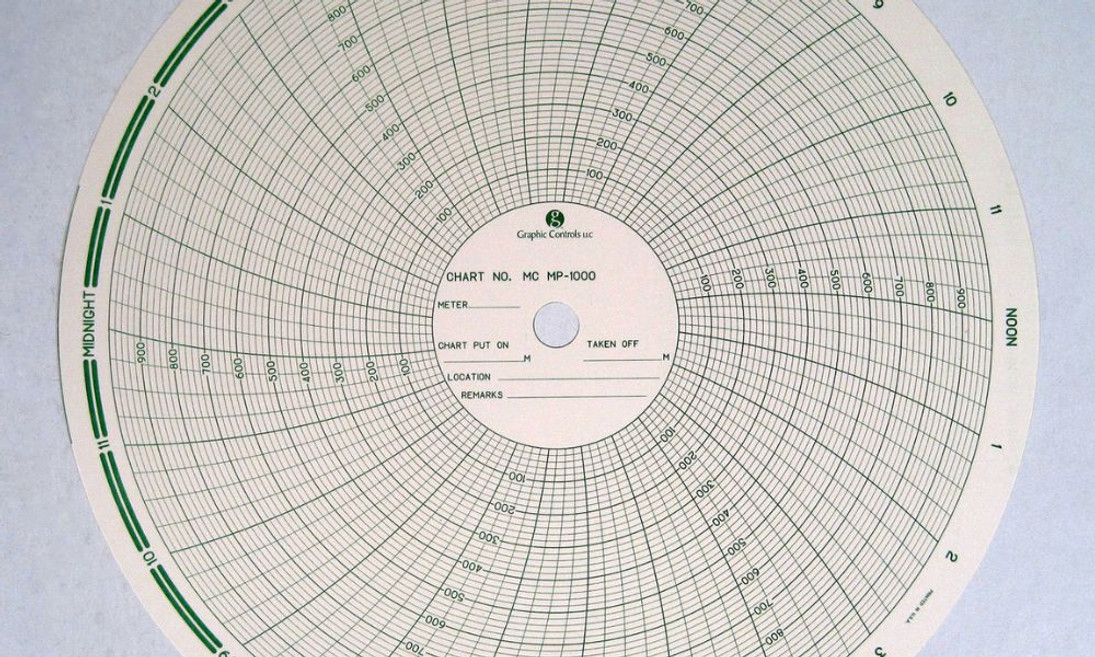8th Sep 2023
Tips for Selecting a Chart Recorder and Pen
Chart recorders and pens play a pivotal role in a multitude of applications. They act as vital tools in the recording and documentation of various physical or electrical phenomena, such as temperature, humidity, pressure, or voltage. Industries ranging from healthcare to manufacturing and scientific research to oil and gas exploration all rely on these devices for accurate, real-time data logging. The importance of chart recorders and pens cannot be overstated, as they not only help monitor essential parameters but also aid in the analysis and prediction of future trends based on past data. Read on to learn some helpful tips for selecting the right chart recorder and pen.
Understanding Chart Recorders and Pens
Before we dive into our list of helpful tips, it’s important to explain more about chart recording equipment and accessories. A chart recorder is a device that records variations in specific conditions over time. It creates a graphical representation of these changes on a moving piece of paper. The recording pen, which moves in sync with the fluctuations, plays a critical role in this process. It marks the paper as it moves, thus creating a visual track of the data. The mechanism that drives the pen varies between models, but the objective remains the same—to generate an accurate, easy-to-read record of the monitored conditions.
The basic functionality of chart recorders and pens involves tracking and documenting changes in one or more variables over a specified period. This could include measurements of temperature, pressure, humidity, voltage, and more, depending on the application. These devices find primary use in sectors where continuous monitoring of certain conditions is crucial. In manufacturing, chart recorders monitor machine performance. In scientific research, they track environmental changes. By providing an ongoing visual record of these variables, chart recorders and pens enable users to identify patterns, anomalies, or trends that might otherwise go unnoticed.
Tips for Selecting a Chart Recorder
One of the most important factors to consider when selecting a chart recorder is the specific application for which you intend to use it. Different applications require different types of recorders. For instance, if you need to monitor temperature in a laboratory setting, you may need a different recorder than someone monitoring pressure in an industrial process. The application not only dictates the type of recorder you need but also influences other factors, such as the range of measurement, the type of input signal, and even the physical size of the recorder. Therefore, understanding your application thoroughly aids in narrowing down your options and helps you select a recorder that best fits your needs.
Chart speed is another significant factor to consider when selecting a chart recorder. Chart speed refers to how quickly the pen moves across the paper, representing the recorded data. Some applications may require a fast chart speed to capture rapid changes in conditions, while others might require a slower speed for long-term monitoring. Choosing a recorder with a chart speed that matches your application’s requirements is essential to ensure that you capture all the necessary data without wasting paper or missing crucial information.
The number of channels a chart recorder has is also a critical consideration. Channels represent the number of separate measurements a recorder can track simultaneously. You will need a multi-channel recorder if your application requires monitoring multiple variables simultaneously, such as temperature and pressure. Conversely, a single-channel recorder will suffice if you only need to track one variable. Remember that more channels usually mean a larger, more expensive recorder, so balancing your needs with your budget is crucial.
In addition to these specific considerations, there are other general tips to remember when purchasing a chart recorder. Ensure the recorder is from a reputable manufacturer and comes with a warranty. Consider the cost of consumables like pens and chart paper, as these can increase over time. Also, think about the environment where you will use the recorder. If it is a harsh or hazardous location, you may need a recorder that can withstand such conditions.
Tips for Selecting a Pen
Selecting a reputable and quality chart recorder consumables distributor is crucial in ensuring a steady and dependable supply of replacement pens for your device. A good distributor will not only provide high-quality products but also offer consistent delivery and excellent customer service. By choosing a reliable distributor, you can ensure that you always have access to the pens you need when you need them, contributing to the smooth operation of your chart recorder.
Another essential tip for selecting a pen for your chart recorder is to ensure you only use pens designed specifically for your device. Using a pen not designed for your particular chart recorder model may lead to inaccurate readings, or it could damage the device. Each chart recorder model has unique specifications, and the pens are designed to meet these specifications. Therefore, using the right pen ensures optimal performance of your chart recorder and safeguards its longevity. Always refer to the manufacturer’s recommendations or consult with your distributor to ensure you choose the right pen for your specific chart recorder model.
Circular Chart Considerations
When purchasing recorders and pens specifically for circular charts, it is vital to consider the size of the chart itself. Circular charts come in various sizes, typically ranging from 4 inches to 12 inches in diameter. The size you choose depends on the level of detail you require in your recordings. Larger charts allow for more detailed recordings, making them ideal for applications that necessitate close monitoring of data over time. However, they also take up more space and may require more frequent paper changes. Therefore, you must balance your need for detailed data with practical considerations, such as available space and maintenance requirements.
Another important factor to consider is which circular chart recorder pens are best for your device. Unlike linear chart recorders, circular chart recorders often use pens with a smaller tip to accommodate the smaller writing area. These pens usually offer high precision but may wear out faster due to the constant circular motion. Ensuring that you have a reliable source of replacement pens designed specifically for circular chart recorders is crucial. You should also ensure that the pens are compatible with your specific recorder model to provide accurate readings and prevent potential damage to the device.
Follow these helpful tips for selecting the right chart recorder and pen to ensure your team has the ideal equipment for your specific application. If you’re not exactly sure which device will work best, reach out to our friendly team here at Recorders Charts & Pens. Aside from offering superior chart recorder consumables, we provide useful resources and information to help you make successful chart recorder purchases.


